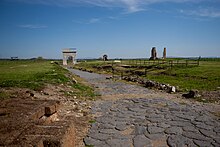Vulci
 The archaeological site of Vulci | |
| Alternative name | Volci, Velch, Velx |
|---|---|
| Location | Montalto di Castro, Province of Viterbo, Lazio, Italy |
| Region | Latium |
| Type | Settlement |
| Site notes | |
| Condition | Ruined |
| Ownership | Public |
| Management | Soprintendenza per i Beni Archeologici dell'Etruria Meridionale |
| Public access | Yes |
| Website | Vulci Archaeological Naturalistic Park |
Vulci or Volci is an Etruscan city (in Etruscan, Velch or Velx, depending on the romanization used) in the Province of Viterbo, north to Rome, Italy.
The Vulci were a tribe or people as well as a city. They were one of the legendary twelve peoples of Etruscan civilization, who formed into the Etruscan League, a confederacy of self-interest. This league splintered apart when opposed by the central government of the Roman Republic, and the Etruscans were soon assimilated. Vulci was abandoned.
Geography


Velch was located near the coast of the Tyrrhenian Sea about 80 km northwest of Rome, on the Fiora River, between Montalto di Castro and Canino. The site is not currently inhabited. The cemeteries and ruins of the city remain.
The circuit of the walls measures about 6.5 km, and scanty traces of them and of Roman buildings within them still exist. The Ponte della Badia[1] over the Fiora, a bridge with a main arch of 20 m span, 30 m above the stream, is also Roman. An aqueduct passes over it.
The former wealth of the town is mainly proved by the discoveries made in its extensive necropolis from 1828 onwards - Greek vases, bronzes and other remains - many of which are now in the Vatican. By 1856 over 15,000 tombs had, it was calculated, been opened. These were entirely subterranean, and little is now to be seen on the site but a great tumulus, the Cuccumella, and a few smaller ones. Many of the tombs date from the 8th century BC.
The frescoes from the François tomb, discovered in 1857, illustrating Greek and Etruscan myths, are now in the Torlonia Museum at Rome. Another important burial chamber, the so-called Isis Tomb, proved to be a rich source of finds, most of which are now in the British Museum.[2] They were at one stage in the possession of Lucien Bonaparte, brother of Napoleon.
Pre-history
A derivation of the name from Indo-European *welk- ("wet, damp"), remains unconvincing. It would not be a Hellenization and there is no evidence of an Italic intrusion before the Roman conquest, nor were Indo-Europeans likely to have been in the area before Etruscan civilization. Currently we do not know enough Etruscan to say what the name might mean in Etruscan.
History
Beginning to expand in the 8th century BC, Vulci reached a floruit in the 6th century BC. It came to command Orbetello, Saturnia, Sovana, Castro, Pitigliano and Marsiliana. It was a maritime power, with a geography similar to that of Rome; that is, located some miles up a river, but close enough to the sea to be a major maritime power. Many Greeks came to live there.
The port of Vulci was at Regae. The origin of the name is not known. An Indo-European root can be found, but, if valid, it is most likely an Italic name assigned by the Romans who conquered the place. Or, it could be a Latinization of an Etruscan name.
Originally the Etruscans were co-founders of Rome and continued to dominate it. Vulci had some influence on early Rome, as Servius Tullius and the Vibenna brothers (Caile and Avle Vipinas) were from Vulci. At Vulci he was a private citizen, Macstarna. Their names and representations appear on a fresco in the François Tomb.
After the population of Rome had become predominantly Italic, the Etruscan kings were overthrown and the Romans fought a long war to reduce Etruria to their dominion. Tiberius Coruncanius triumphed over the people of Vulsinii and Vulci in 280 BC. and the colony of Cosa was founded in their territory. The Romans took the coast from them, cutting the base of their power. This seems to have led to the decline and eventual abandonment of the city.
Vulci does not seem to have been of great importance in the remaining Roman period, even though the Romans pushed the Via Aurelia through it in 240 BC. A surviving milestone gives the distance to Rome as 70 milia passuum.
Later it became an episcopal see.
Other
The Etruscan goddess Turan was the patroness of Vulci. The area also houses a mithraeum.
References
- This article incorporates text from a publication now in the public domain: Chisholm, Hugh, ed. (1911). Encyclopædia Britannica (11th ed.). Cambridge University Press.
{{cite encyclopedia}}: Missing or empty|title=(help)
Footnotes
External links
- Vulci Archaeological Naturalistic Park
- National Archaeological Museum of Vulci
- Velch
- Vulci
- Harris, W., R. Talbert, T. Elliott, S. Gillies. "Places: 413393 (Vulci)". Pleiades. Retrieved March 8, 2012.
{{cite web}}: CS1 maint: multiple names: authors list (link)


